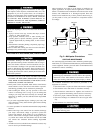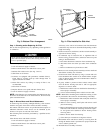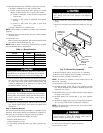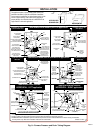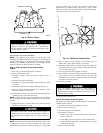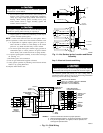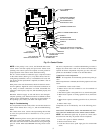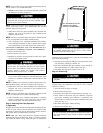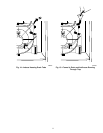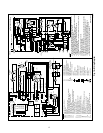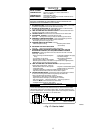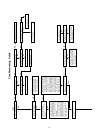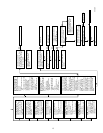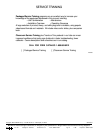
Never use matches, candles, flame, or other sources of
ignition to check for gas leakage. Use a soap-and-water
solution. Failure to follow this warning could result in a fire,
personal injury, or death.
18. Replace main furnace door.
SECONDARY HEAT EXCHANGERS
NOTE: The condensing side (inside) of the secondary heat
exchangers CANNOT be serviced or inspected. A small number of
bottom outlet openings can be inspected by removing the inducer
assembly. See Flushing Collector Box and Drainage System
section for details on removing inducer assembly.
Step 5—Flushing Collector Box and Drainage
System
1. Turn off gas and electrical supplies to furnace.
2. Remove main furnace door.
3. Disconnect inducer motor and pressure switch wires or
connectors.
4. Disconnect pressure switch tubes.
5. Disconnect vent pipe from inducer housing outlet by loosen-
ing clamp.
6. Disconnect drain tube from inducer housing. (See Fig. 8.)
7. Remove inducer housing assembly by removing 4 bolts
attaching assembly to cell panel.
8. Flush inside of collector box with water until discharge from
condensate trap is clean and runs freely.
NOTE: Ensure the drain tube disconnected from the inducer
housing is higher than the collector box opening or water will flow
out tube.
9. Inspect inside area of collector box for any pieces of foreign
materials and remove if present.
DO NOT use wire brush or other sharp object to inspect or
dislodge materials in secondary heat exchangers as failure of
the secondary heat exchanger will occur. Flush with water
only.
10. Reassemble inducer assembly by reversing items 5 through 7.
NOTE: If seal between the inducer housing and the collector box
is damaged in any way, it must be repaired. To repair, apply
sealant releasing agent such as PAM cooking spray or equivalent
(must not contain corn or canola oil, aromatic or halogenated
hydrocarbons) to inducer housing. (See Fig. 10.) Apply a small
bead of G.E. RTV 162, G.E. RTV 6702, or Dow-Corning RTV
738 sealant to groove in collector box.
11. Refer to furnace wiring diagram and reconnect wires to
inducer motor and pressure switch or connectors.
12. Reconnect pressure tubes to pressure switch. See diagram on
main furnace door for proper location of tubes. Be sure tubes
are not kinked. (See Fig. 8.)
13. Turn on gas and electrical supplies to furnace.
14. Check furnace operation through 2 complete heat operating
cycles. Check area below inducer housing, vent pipe, and
condensate trap to ensure no condensate leaks occur. If leaks
are found, correct the problem.
15. Check for gas leaks.
Never use matches, candles, flame, or other sources of
ignition to check for gas leakage. Use a soap-and-water
solution. Failure to follow this warning could result in a fire,
personal injury, or death.
16. Replace main furnace door.
Step 6—Servicing Hot Surface Ignitor
The ignitor does NOT require annual inspection. Check ignitor
resistance before removal.
1. Turn off gas and electrical supplies to furnace.
2. Remove main furnace door.
3. Disconnect ignitor wire connection.
4. Check ignitor resistance.
a. Using an ohm meter, check resistance across both ignitor
leads in connector.
b. Cold reading should be between 45 ohms and 90 ohms.
c. If ohm reading is higher than 110 ohms, ignitor is cracked
and must be replaced.
5. Remove ignitor assembly.
Fig. 9—Burner Flame
A89020
BURNER FLAME
BURNER
MANIFOLD
Fig. 10—Gasket on Collector Box
A93081
RTV
PAM
7




